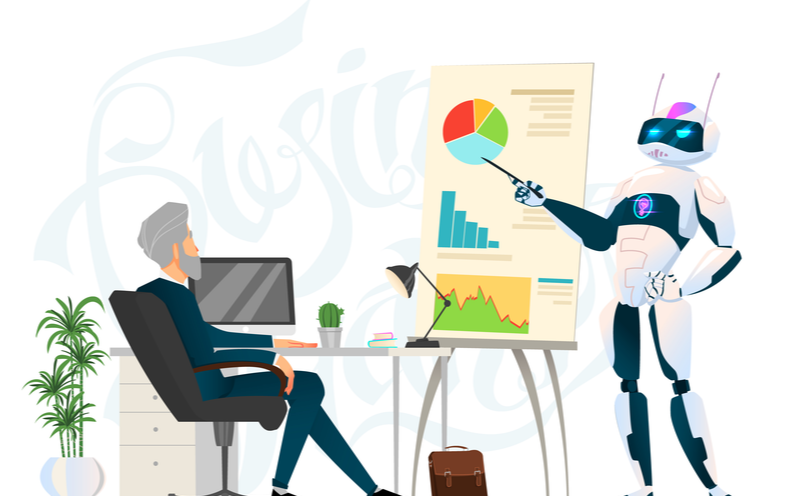As the Russian invasion of Ukraine enters its third month, one AI company is helping the Ukrainian army intercept unencrypted radio communications between Russian military commanders to help troops better anticipate what they might encounter on the battlefield.
But unlike traditional communications surveillance, where linguists and analysts listen to each minute of radio chatter hoping to extract actionable information, Primer AI uses augmented analytics—a form of automated, always-on artificial intelligence that skims the most relevant information from these exchanges. Its models can extract mentions of location, persons, topics of interest, and even military equipment to identify trends and generate summaries of what was said. All communications are translated from Russian to English using natural language processing, a branch of AI that enables machines to understand both text and spoken words.
Read on to learn more about what augmented analytics is, and how this emerging technology could radically transform the data science process.
What Is Augmented Analytics?

Augmented analytics is a technology stack that automates data cleaning and analytics. Analyst firm Gartner, which coined the term in 2017, predicted that augmented analytics “marks the next wave of disruption in the data and analytics market.”
Augmented analytics is faster than a human analyst, and can infer patterns and correlations that would otherwise take days or even weeks to unearth.
Unlike traditional data science and machine learning (DSML) products, augmented analytics platforms provide always-on, real-time analysis, and the ability to search databases using natural language, instead of writing SQL queries. Augmented analytics also automates repetitive tasks like data cleaning and basic pattern recognition.
How Does Augmented Analytics Work?
Augmented analytics is an example of human-machine interaction in the data science field.
Like the terms “metaverse” or “cyberspace,” augmented analytics doesn’t refer to a specific technology. Instead, it’s an umbrella term for tools and software that provide automated analytical capabilities—either recommendations, insights, or guidance on a query.
Augmented analytics is supported by natural language interfaces, including conversational interfaces that support natural language queries and explanations. At the heart of all augmented analytics tools is a search engine that lets users query databases using natural language instead of SQL queries. For example, a product manager could write, “What is the top-selling product in X region?” and the platform will return corresponding metrics and data visualizations.
Get To Know Other Data Science Students
Jonah Winninghoff
Statistician at Rochester Institute Of Technology
Hastings Reeves
Business Intelligence Analyst at Velocity Global
Peter Liu
Business Intelligence Analyst at Indeed
Augmented Analytics Examples and Use Cases
Here are some real-world examples of how augmented analytics is being used.
- Helping first responders navigate dangerous situations
In 2020, IEEE fellow Karen Panetta initiated a project with the Boston Fire Department to use AI for object recognition, which provides firefighters with real-time data about fire locations, materials burning, and possible dangers—all before arriving at the scene. By using data from sensors that firefighters wear, this technology recognizes objects that can be navigated in a fire. Augmented analytics capabilities ensure new data is immediately interpreted, categorized, and contextualized as emergency situations evolve.
- Enhancing targeted advertising using image recognition
In 2017, Coca-Cola promoted its Gold Peak brand of iced tea by experimenting with augmented analytics. The soft drink giant used image recognition technology to identify people who posted images on Facebook, Twitter, and Instagram with glasses or jugs of tea, or had posted photos of tea products from competitors such as Lipton, Snapple, or Honest Tea. Then, they targeted these users with ads from Coca-Cola.
- Empowering everyday people with information to enhance their safety
Founded in 2017, Citizen is a mobile app that sends users real-time, location-based alerts. The app works by aggregating data from 911 alerts, social media posts, and police scanners to provide users with information about crimes, fires, and natural disasters. Augmented analytics works in the background to interpret unstructured data from multiple sources and provide users with a “newsfeed” of what’s happening in their area.
Where Does Augmented Analytics Fit Into Your Business?

Businesses use augmented analytics to reduce the time and cost of preparing data, find insights from their data, communicate these findings, and take action. The visual exploration features on augmented analytics platforms allow users to interact with the data using natural language and visualization.
Here are some other ways that augmented analytics can help your business:
- Augmented data preparation: The machine learning and AI capabilities provided by augmented analytics platforms can accelerate data profiling, data modeling, manipulation, and more. These algorithms can also detect schemas and joins, profiling, and data enrichment.
- Automated analytics: This allows businesses to run always-on analysis, which automates the manual data discovery process, and allows for the continuous generation of data insights. Users can also find, visualize and narrate relevant discoveries without having to build models or write algorithms.
- Natural language generation (NLG): NLG automatically generates rich descriptions to make complex information easier to understand. Augmented analytics can also read and interpret text or voice data, enabling the user to engage with the data through a more intuitive interface.
- Machine-assisted insights: Augmented analytics platforms offer machine-generated visualizations, calculations, and variance analysis which can be triggered by the user simply asking a question rather than having to write code. For example, a user could see a spike on a chart and click on the spike to see an explanation of why the spike occurred.
Augmented Analytics vs. Data Analytics

Some of the concepts of augmented analytics might sound identical to data analytics, but there are differences between the two. Data analytics is the process of analyzing raw data to find trends and answer questions. With augmented analytics, an organization can jump from collecting data to generating insights—as long as the data is accurate, complete, and up-to-date. While augmented analytics platforms can clean data, they can’t fix poor data quality.
Augmented Analytics vs. Business Intelligence
Augmented analytics platforms build upon traditional business intelligence tools by enhancing them with AI and machine learning technologies. Business intelligence tools collect and process unstructured data and present analytical findings in reports, dashboards, charts, and graphs to provide users with detailed insights into the state of the business. Augmented analytics continuously learns from the data in order to generate predictive insights and make recommendations. While business intelligence data is merely descriptive–what is happening, when it happened, and whom it concerns—augmented analytics explains why something happened and whether it will happen again.
Augmented Analytics vs. Predictive Analytics
While augmented analytics tools are capable of predictive modeling, predictive analytics refers to a specific type of AI-powered forecasting. Predictive analytics uses machine learning and statistical techniques to predict future outcomes based on historical data. Augmented analytics, on the other hand, is a general analytics tool used to support human intelligence and expedite repetitive tasks.
What’s the Future of Augmented Analytics?

Augmented analytic tools shorten the time between data being collected and insights being generated. They also enable organizations to employ fewer data scientists while ingesting and mining larger volumes of data.
However, one of the biggest problems with augmented analytics is that the data analysis process leads to errors that are glaringly obvious to humans, but not so to a machine. Spurious correlations occur when two variables appear to have a cause-and-effect relationship—at least statistically—even if this correlation makes no sense in the real world.
While augmented analytics certainly has the potential to expedite rote processes like building ETL pipelines, it can’t be trusted to make executive decisions such as which data sources to use, establishing rules for data governance, and writing algorithms.
Augmented Analytics FAQs
Should You Learn Augmented Analytics?
While it’s unclear how many organizations are currently using augmented analytics, industry analysts predict that the market for augmented analytics will reach $30 billion by 2027. This suggests that augmented analytics could become a standard tool in the data scientist’s toolkit. Familiarity with augmented analytics will put you ahead of the competition when you apply for your next data science job.
Should You Invest in Augmented Analytics?
Augmented analytics is worth the investment for companies wanting to scale their existing data science process. Companies with sufficient data maturity can use an augmented analytics platform to analyze larger volumes of data and shorten the data science process. However, in order to gain the most benefit from an augmented analytics platform, companies should already practice good data governance.
Since you’re here…Are you interested in this career track? Investigate with our free guide to what a data professional actually does. When you’re ready to build a CV that will make hiring managers melt, join our Data Science Bootcamp which will help you land a job or your tuition back!






